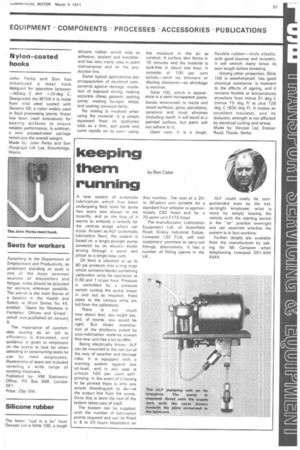Silicone rubber
Page 59

If you've noticed an error in this article please click here to report it so we can fix it.
The latest "tool in a tin" from Devcon Ltd is Silite 100, a tough silicone rubber which acts as adhesive, sealant and insulator, and has very many uses in plant maintenance and on the production line.
Some typical applications are; encapsulation of electrical cornponents against damage; insulation of exposed wiring; making accurate cheap gaskets; sealing joints; making bumper strips; and coating conveyor belts.
No mixing is involved when using the material. It is simply squeezed from its applicator tube as a firm, soft paste and cures rapidly on its own—using the moisture in the air as catalyst. A surface Skin forms in 10 minutes and the material is tack-free in about one hour. It consists of 100 per cent solids—with no thinners or diluting elements—so shrinkage is minimal.
Silite 100, which in appearance is a semi-transparent paste, bonds tenaciously to metal and wood surfaces, glass, porcelains, ceramics and most silicones (including itself). It will bond to a painted surface, but paint will not adhere to it.
Upon cure, it is a tough, flexible rubber—truly elastic, with good bounce and recovery. It will stretch many times its own length before breaking.
Among other properties, Silite 100 is weatherproof, has good chemical resistance, is resistant to the effects of ageing, and it remains flexible at temperatures anywhere from minus 51 deg C (minus 75 deg F) to plus 126 deg C (500 deg F). It makes an excellent insulator, and its dielectric strength is not affected by electrical cycling and stress. Made by: Devcon Ltd, Station Road, Theale, Berks.




































































































